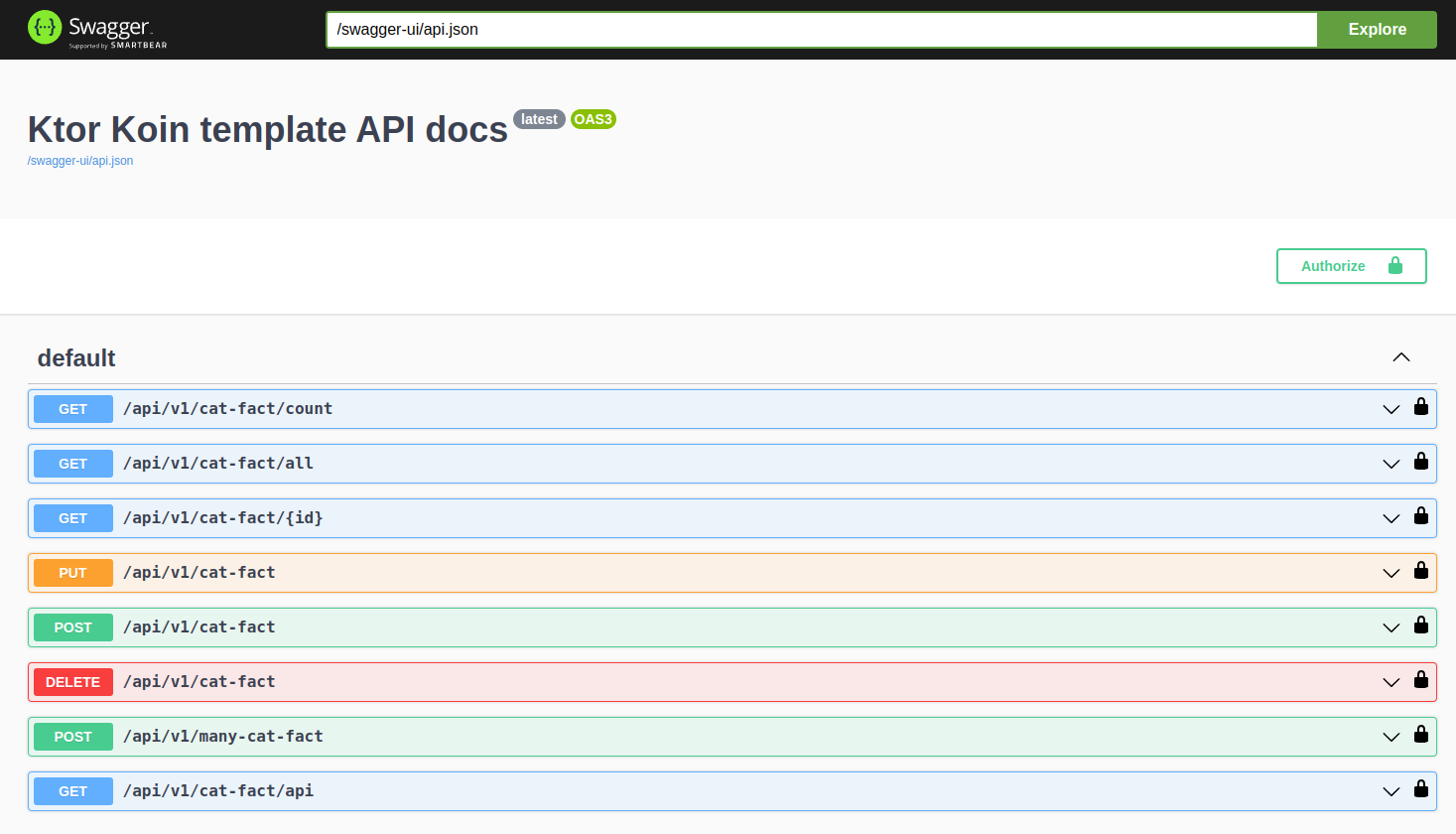Run docker compose
To build the app run ./gradlew build
To run the app run ENV=local ./gradlew run This will use the local.yaml file which contains defaults for local
development.
Imagine, you want to create a simple endpoint for you resource because you like cats. Most of the time, you want to fetch facts from your database.
Sometimes, you want to access external API for the fact, for inspiration of course ;)
Note: The OpenAPI paths are auto generated based on registered paths

Start with defining the Model data class:
data class CatFact(
@BsonId override val id: ObjectId? = null, //@BsonId is needed
val fact: String,
) : Model
// To force implement id
interface Model {
val id: ObjectId?
}Next create repository
@Singleton // Koin annotation to be able to be auto-wired
class CatFactRepository(
mongo: Mongo // autowire Mongo (holding connection) into repository
) : MongoCrudRepository<CatFact>(
// extend CRUD repo with pre-made functions + provide our Model
mongo = mongo,
databaseName = "ktor-sample", // name of Mongo database
) {
// Get collection from ktor-sample database. Every operation will work on this collection
override fun MongoDatabase.selectRepositoryCollection() = getCollection<CatFact>("cat-facts")
// you add you own specific queries here
suspend fun mySpecialFunction() = withCollection {
// we are already in scope of MongoCollection<CatFact> here, so it's easy to work with
}
}After that, move to the next layer, service. In service, you can combine multiple repositories, or even other dependencies
In this case we will combine repository access with client that fetches random fact from https://catfact.ninja
@Singleton
class CatFactService(
private val catFactClient: CatFactClient,
private val catFactRepository: CatFactRepository, // our previously created repository
) : ModelService<CatFact>(catFactRepository) { // we get basic functions from abstract repository
//... and then we can define more
suspend fun getFactFromApi(): CatFact = catFactClient.getCatFact()
//... or create specific functions for our use case and using catFactRepository directly
suspend fun deleteWhereCatFactMatching(fact: String) = catFactRepository.deleteWhere {
Filters.eq(CatFact::fact.name, fact)
}
}And as a last step, create controller:
@Singleton(binds = [Controller::class]) // has to bind Controller::class in order to auto-create routes
class CatFactController(
private val catFactService: CatFactService, // we will be using previously created cat sercive
private val useBearerAuth: Boolean // if true, Bearer token auth is turned on automatically.
// If false no auth is provided. You can add your auth in additionalRoutesForRegistration()
) : RestController<
CatFact, // MODEL -> The Model that we are using
SaveCatFactRequestBodyListItem, // REQUEST_DTO -> Class that will be treated as incoming JSON
CatFactResponseDto // RESPONSE_DTO -> Our controller will respond with this class
>
(
basePath = "api/v1", // the base path that all of our routes will have
// if false, you would need to add routes directly to additionalRoutesForRegistration()
// use false when you want to publish only read operations for example
autoRegisterRoutes = true,
service = catFactService,
) {
override fun Route.additionalRoutesForRegistration() {
// only routes in here will get registered
getFactFromApi() // if you don't add the route here specifically, it will NOT be registered!
}
override fun getNameOfModelForRestPath() = "cat-fact" //the common path after base path
// we have to define types specifically as we are working with generics
// haven't found better way yet :(
override fun requestDtoTypeInfo() = typeInfo<SaveCatFactRequestBodyListItem>()
override fun listRequestTypeInfo() = typeInfo<ListWrapperDto<SaveCatFactRequestBodyListItem>>()
override fun responseDtoTypeInfo() = typeInfo<CatFactResponseDto>()
override fun listResponseDtoTypeInfo() = typeInfo<ListWrapperDto<CatFactResponseDto>>()
// provide mapping functions between REQUEST_DTO -> MODEL-> RESPONSE_DTO
// Note: If you don't want to use different classes, just define all as CatFact
override fun CatFact.toResponseDto() = toDto()
override fun SaveCatFactRequestBodyListItem.requestToModel() = toModel()
// ... and create more routes! Always extend Route.
private fun Route.getFactFromApi() = get("/${getNameOfModelForRestPath()}/api", {
// In this block, specify the OpenAPI specs
response { HttpStatusCode.OK to { body(responseDtoTypeInfo().type) } }
}) {
//respond with cat fact from API (not db this time)
call.respond(catFactService.getFactFromApi().toResponseDto())
}
}And that's it! Run application and you can enjoy your endpoints!
Also don't forget that it's possible to add any number of endpoints to this controller as with the getFactFromApi()
which is not interacting with MongoDB at all dor example.
Ktor was chosen as it's written in Kotlin and supports coroutines natively
Koin as DI (Dependency Injection) was chosen as it's comfortable to use for development
especially with the addition of koin-annotations. Just mark class as @Singleton and it's ready to be used.
MongoDB provides great Kotlin integration utilizing coroutines and Flow. Seamless integration with data objects.
Example how to create basic REST API very quickly, without the need to care about database at all
PostgresSQL will be added into the stack. Replaced with Mongo
Examples of how to use coroutines / channels / flows.
Testability of API / Services. Working with mocks.
Hey that's super welcome!
Either open PR or reach me on my email krason.tomas@gmail.com regarding any ides.
application -> contains code for running Koin, Server modules etc.
client -> contains clients that extract or load data from/to different servers. Client functions SHOULD return * model*.
controller -> contains code specifying what endpoints will be available on this server. Controller SHOULD NOT return model.
model -> internal representation of objects. Model SHOULD NOT be @Serializable
service -> contains business logic
repository -> access to DB layers